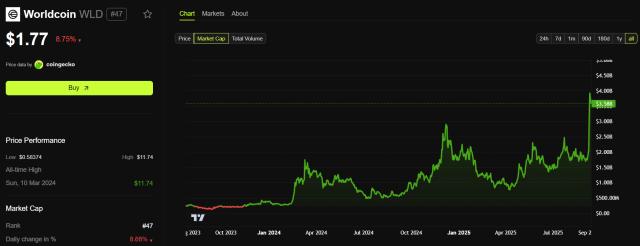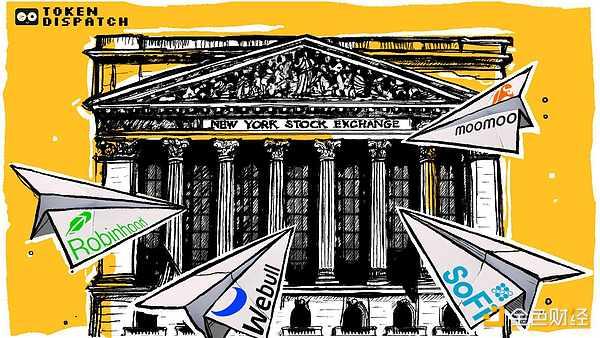Author: CoinW Research Institute
On September 8, 2025, Nasdaq submitted a compelling proposal to the U.S. Securities and Exchange Commission (SEC): it plans to allow "tokenized securities" to be traded on the Nasdaq exchange, subject to the same trading rules and execution priorities as traditional securities. While seemingly a mere rule revision, this could be a crucial step for Wall Street to embrace blockchain.
1. Key Points of Nasdaq's Proposal
Allowing tokenized stocks to be traded alongside traditional stocks
In its latest proposal, Nasdaq stated its intention to allow the trading of tokenized securities, applying the same trading rules as for conventional securities. This means that in the future, shares issued by the same company, whether in traditional form or tokenized on a blockchain, will be traded on Nasdaq under the same rules, enjoying the same matching priority and shareholder rights. This not only ensures price discovery and liquidity, but also provides investors with a virtually seamless trading experience, eliminating the need to worry about buying a "watered-down" version of the stock. This is a significant signal of the accelerating convergence of traditional finance and the blockchain world.
It's worth noting that Nasdaq specifically emphasizes that only tokenized securities with rights identical to those of traditional securities will receive equal treatment. This means that investors should enjoy the same voting rights, dividend rights, liquidation rights, and information disclosure rights through tokenized securities as they do directly holding traditional securities. In other words, tokenization merely changes the technical methods of holding and trading; it does not affect investors' legal status or economic interests.
The difference in rights must be clearly defined and the clearing system can identify them normally.
To avoid confusion, Nasdaq requires that any differences in rights between tokenized securities and traditional securities be clearly marked to facilitate identification by clearinghouses and investors. Clearing and settlement will continue through existing systems, such as the Direct Trading Center (DTC) in the United States, but will be upgraded to support on-chain delivery in the future. This allows both institutional and retail investors to access on-chain assets within a familiar trading environment without worrying about liquidation risks.
Infrastructure compatible, no need to significantly adjust the system
This proposal does not require a complete rebuild of the trading system, but rather fine-tunes existing rules to maintain consistency in trading, fees, matching priorities, market monitoring, etc. This will help ensure that liquidity is not fragmented and allow tokenized securities to become part of the traditional market.
Execution priorities and market participation remain unchanged
Whether using traditional or tokenized trading formats, order processing, priority, fee structure, routing strategy, market monitoring, and the National Best Bid and Offer (NBBO) mechanism remain consistent with traditional securities trading. Tokenized shares will not be subject to any changes in execution treatment depending on the format.
Ensure market stability and transparency
Nasdaq emphasized that tokenized trading will not disrupt market structure or price disclosure mechanisms, lead to liquidity fragmentation, or compromise investor protection. All transactions will remain subject to monitoring and review by regulatory bodies such as Nasdaq and FINRA, maintaining market transparency and oversight to prevent market manipulation.
2. Why this is an event worth noting
Historically, mainstream exploration in the RWA space has focused on products like stablecoins and tokenized government bonds, such as on-chain versions of U.S. Treasury bonds and corporate bonds. The core principle is to map real assets (US dollars, government bonds, and bonds) onto the blockchain, allowing users to more efficiently hold, transfer, and settle within the crypto ecosystem. In other words, most of the "tokenized stocks" that have appeared on the market in the past were simply price mappings, not true equity, and did not grant investors core rights like voting rights and dividends. Users were not actually buying the stock itself.
Nasdaq's proposal is completely different. It requires that tokenized shares must have the same rights as traditional stocks in order to enter the same trading system. This means that the rights obtained by investors through tokenized shares are no different from those of directly holding shares, making them truly on-chain shares.
More importantly, this proposal signals the beginning of traditional financial markets' embrace of blockchain, integrating it into core trading infrastructure, rather than confining it to experimental or over-the-counter trading. Once implemented, it could significantly improve market efficiency, reduce clearing costs, and attract more institutional and retail investors to experiment with blockchain assets. This is not only a recognition of blockchain technology, but also a potential turning point in the deep integration of traditional finance and the crypto world.
3. Response within the industry
Nasdaq’s proposal is not an isolated incident, but can be said to be a continuation of the entire financial market’s exploration of tokenization.
On September 3, 2025, Galaxy Digital announced a partnership with SEC-registered transfer agent Superstate to directly tokenize its Class A common stock, GLXY, on the Solana blockchain through its Opening Bell platform. This marked the first time a US public company has proactively put its actual shares on-chain, granting token holders the same legal and economic rights as traditional shares, including voting rights, dividend rights, and liquidation rights, truly achieving "stock on-chain."
That same month, Ondo Finance announced the official launch of its Ondo Global Markets exchange, offering tokenized versions of over 100 US stocks and ETFs to non-US investors, with 24/5 trading and 24/7 transferability. These tokens are pegged 1:1 to real shares, held by regulated US brokerages, and offer the same liquidity as traditional exchanges. The platform currently runs on Ethereum and will expand to Solana and BNB Chain, with plans to support over 1,000 assets by the end of the year. This means global investors can access the US stock market 24/7 through on-chain wallets and freely apply tokenized securities in DeFi scenarios.
Previously, Robinhood pioneered tokenized US stocks and ETFs in Europe, covering over 200 assets. They also plan to bring equity in private companies like SpaceX and OpenAI onto the blockchain, testing the waters for tokenized trading of private equity. Kraken also launched its xStocks product, which supports tokenized versions of over 50 US stocks and ETFs. Running on Solana, it allows users to trade 24/7 and withdraw to on-chain self-custody.
These events collectively highlight a trend: traditional capital markets are attempting to merge with the openness and programmability of blockchain. The most direct change brought about by tokenization is that it breaks down time and geographical constraints, allowing US stocks, ETFs, and even private equity to be traded in a 24/7 on-chain market and directly embedded in DeFi applications as collateral or liquidity tools. This means that global investors will no longer be constrained by local exchange hours and will have access to a wider range of asset allocation options on-chain. Markets and institutions have long been exploring the potential of putting stocks on-chain, and if implemented, Nasdaq's proposal will provide a broader platform for these explorations, bringing tokenized securities into the mainstream and accelerating the integration of traditional finance and the blockchain world.
4. Potential impact: A new narrative for financial markets
Stimulus for the crypto market
Nasdaq's proposal will undoubtedly inject new heat into the RWA (Real World Asset) sector. Allowing tokenized stocks to trade alongside traditional stocks will directly connect crypto technology to one of the world's largest stock markets, significantly increasing market potential and potentially impacting multiple Web3 sectors.
First, DeFi lending and derivatives protocols. Tokenized US stocks and ETFs can become new high-quality collateral, increasing the depth and diversity of lending pools. Users can borrow or provide liquidity using not only stablecoins and native tokens, but also on-chain stocks like Apple and Tesla. This will improve the capital efficiency of the protocols and may lead to cross-asset collateralization products such as "on-chain stocks + stablecoins." Derivatives will also benefit, with the introduction of perpetual contracts, options, and other derivative instruments based on on-chain stocks, allowing users to more conveniently hedge and leverage trading.
Next is RWA (Real World Assets) and asset management protocols. Putting stocks on-chain will enrich the RWA asset pool, extending it beyond low-risk assets like government bonds and commercial paper. On-chain asset managers can create index funds, smart portfolios, or automated rebalancing strategies that include on-chain stocks, allowing ordinary users to access "on-chain ETFs" or thematic investment portfolios with a lower barrier to entry.
At the same time, this will also benefit projects that provide underlying infrastructure for tokenization, such as Chainlink (oracle, price feed), Avalanche, Polygon and other public chains (custody and settlement layers). They are expected to become the technical support for stocks on the chain, ushering in new demand and traffic.
Finally, compliance and identity (DeFi KYC, on-chain identity) will also garner increased attention. Stocks moving to blockchains inevitably require compliance with securities laws, imposing stricter requirements for investor eligibility, geographic restrictions, and holding disclosures. This will drive the adoption of on-chain KYC, verifiable credentials (VC), and compliance modules.
More importantly, this will attract more institutional funds to refocus on the actual application value of blockchain, rather than just hype, thereby driving the expansion of secondary market sentiment and DeFi scenarios.
Impact and opportunities on traditional financial markets
From the perspective of traditional financial markets, the introduction of tokenized stocks has the potential to significantly reduce intermediary costs for trading and clearing. Currently, stock transactions typically require T+2 settlement, involving multiple layers of custodians and clearing institutions. On-chain tokenized stocks, however, can achieve near-instant settlement, reducing reliance on intermediaries and improving capital efficiency. For market participants, this means greater liquidity, lower capital tied up, and the possibility of 24/7 trading.
This efficiency improvement presents both a challenge and an opportunity for traditional intermediaries. While some brokerages and custodians may face disintermediation in their matching and settlement businesses, they also have the opportunity to transform into on-chain custodians and compliance gateways, exploring new revenue models. Clearing houses and central depositories (such as DTCs) will need to upgrade their systems to support on-chain settlement, or risk losing their core role in financial infrastructure.
For businesses, putting stocks on the blockchain can significantly lower financing barriers and costs, allowing them to directly reach global investors. On-chain smart contracts can also be used to update shareholder rosters, distribute dividends, and conduct governance voting in real time, reducing labor and time costs and improving corporate governance efficiency. Furthermore, tokenization of private equity and secondary markets can increase equity liquidity, accelerate the exit process for venture capital and private equity funds, and transform the valuation and liquidity structure of traditional capital markets.
Overall, the integration of stocks into blockchain will drive the evolution of the capital market from a closed system centered on states and exchanges to a global, 24/7, and open market with disintermediation. Traditional brokerages, clearing houses, and custodian banks need to proactively plan their strategies to remain relevant in this new competitive landscape. Enterprises, on the other hand, need to proactively plan their digital strategies to capitalize on the efficiency dividends of on-chain financing and governance. As more and more compliance pathways and technical solutions are implemented, this trend is virtually irreversible. The future global capital market may become dominated by blockchain, further blurring the lines between traditional and decentralized finance.
5. Risks and Challenges
Regulatory uncertainty
While Nasdaq's proposal is a positive innovation, it still requires SEC approval. While the SEC's review period typically has no fixed limit, historically, most exchange-submitted proposals have taken between 30 and 90 days, with complex products potentially taking longer. The review focuses on compliance with the Securities Exchange Act, the adequacy of investor protections, and the rationality of trading rules and market risk controls. For innovative initiatives like the initial tokenization of stocks, the SEC may conduct multiple rounds of inquiries and revisions, resulting in a more rigorous review process and potentially a longer duration.
At the same time, regulators may be concerned that tokenized shares could be used to circumvent certain regulatory requirements, such as cross-border investment restrictions, KYC/AML compliance, and tax reporting. If approval cycles are too lengthy or regulatory requirements are too stringent, the entire tokenization process could be slowed down, and projects could even lose their early advantages.
For example, Ondo Global Markets, mentioned earlier in this article, provides global investors with access to investment by tokenizing traditional securities. Regarding cross-border compliance, the platform is only open to non-US investors and utilizes Reg D and Reg S structures to ensure compliance with US and international regulatory requirements. Regarding Know Your Customer (KYC)/AML, the trading platform rigorously verifies user identities, including identification, address, and tax information, and embeds smart contracts to automatically enforce compliance and trading restrictions. Regarding taxation, withholding tax is applied to investor returns, and transparent transaction and tax records are provided to help investors fulfill their reporting obligations.
Technical and security risks
Tokenized stocks mean that stock holdings and transaction settlements will rely on blockchain technology. Any vulnerability, attack, or downtime on the underlying public blockchain could directly impact settlement security, leading to investor asset losses. Furthermore, on-chain identity verification (ensuring only accredited investors hold shares) presents both technical and regulatory challenges.
Liquidity and price control risks
In traditional markets, pre-market and after-hours trading carries the risk of sudden price fluctuations, but due to limited trading hours, market fluctuations are concentrated around the opening and closing times. On-chain, 24/7 trading changes this centralized trading model, but it doesn't eliminate the risk; it simply takes a different form: from concentrated price fluctuations to the potential for "continuous low-liquidity fluctuations" and "spread arbitrage opportunities."
The circulating market for on-chain tokenized stocks is typically smaller than that of traditional stock markets, and the initial participant structure may be uneven. This makes prices prone to sharp fluctuations and may cause short-term disconnects from traditional market prices. While on-chain trading allows for 24/7 trading, enabling more continuous price discovery, 24/7 trading does not eliminate risk. If market depth is insufficient or individual transaction volumes are large, prices can still be rapidly driven up, leading to unreasonable deviations.
The controllability of on-chain price fluctuations relies on several prerequisites. First, sufficient liquidity support, such as a market maker mechanism, is required to mitigate the impact of large transactions on prices. Furthermore, circuit breakers can suspend trading during unusual fluctuations to prevent a chain reaction. If on-chain stocks have exactly the same rights as traditional stocks and are freely redeemable, cross-market arbitrage will naturally take effect, anchoring on-chain prices to traditional stock prices. For example, when the on-chain stock price is lower than the traditional stock price, arbitrageurs will buy on-chain and sell with traditional stocks; conversely, when the on-chain stock price is lower, they will buy with traditional stocks and sell on-chain, profiting from the price difference and driving price convergence.
Furthermore, the efficiency of settlement and clearing between on-chain and traditional markets also impacts risk. If upgrades to custodians or clearing institutions lag, on-chain transactions may not smooth price fluctuations as theoretically expected. Even if Nasdaq shares a common order book, liquidity imbalances, price gaps, and arbitrage opportunities may still arise in the early stages. Therefore, a comprehensive range of technical, market, and regulatory measures are needed to mitigate these risks.
6. Conclusion
If tokenized stocks can be extended to mainstream exchanges like Nasdaq and traded alongside traditional stocks, new opportunities will emerge for investors. In addition to prioritizing projects in the tokenized infrastructure and RWA sectors, investors should also pay close attention to public chains and exchanges that are actively developing compliance and supporting tokenization. These may become important gateways to and beneficiaries of future capital market on-chain transactions.
From a longer-term perspective, this trend has the potential to drive the full integration of capital markets onto blockchain, enabling real-time, transparent, and automated asset trading, settlement, and custody. The integration of Web3 and traditional finance will be further accelerated, propelling global capital markets into a new era of greater efficiency and openness.








